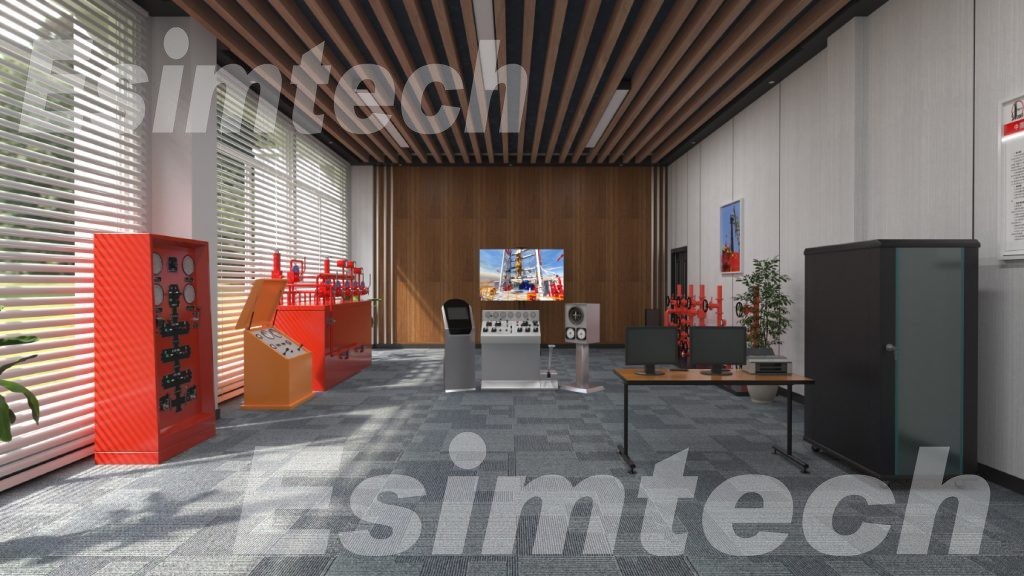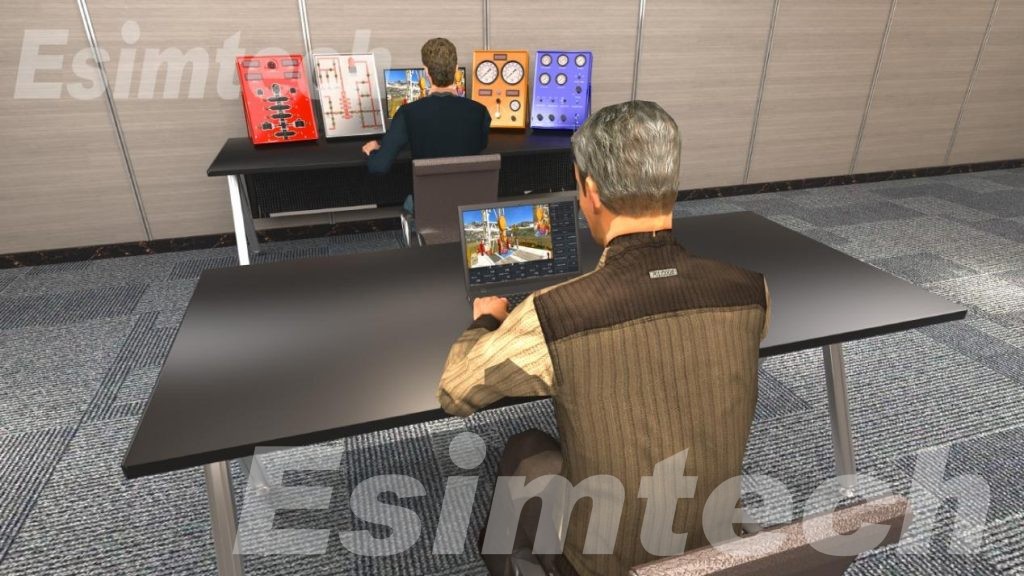Downhole operation is an important link in the process of oil production and development, mainly engaged in oil and gas production, maintenance and oil reservoir transformation and other operations. The main equipment used is a workover rig, fracturing truck, sand mixer, workover string and fracturing string. In addition to some control equipment, most of the working process of underground operation is completed in the wellbore under the formation, which is in an invisible state.
The characteristics of underground operations make it very difficult for teachers to explain and students to understand the relevant technology and process in the training process. For this reason, the Esimtech has built a virtual simulation training system for downhole operation.
Through this training system, students can learn the working principle and operation method of downhole operation simulator, fracturing and acidizing process, and workover rig process, etc…
What are Downhole Operation Simulator?
Downhole operation simulators are software tools used in the oil and gas industry to simulate various downhole operations and evaluate the performance of oil wells. These simulators use mathematical models and algorithms to mimic the behavior of oil wells, allowing engineers and operators to test different scenarios and strategies for optimizing well performance.
What is Downhole Operation? Downhole operation is an important link in the process of oil production and development, mainly engaged in oil and gas production, maintenance and oil reservoir transformation and other operations. The main equipment used is a workover rig, fracturing truck, sand mixer, workover string and fracturing string. In addition to some control equipment, most of the working process of underground operation is completed in the wellbore under the formation, which is in an invisible state.
How Does Downhole Operation Simulator Work?
With a downhole operation simulator, users can simulate a range of operations, such as drilling, completion, workover, and intervention, and analyze the effects of different variables such as wellbore geometry, reservoir properties, and fluid flow behavior. Simulators can also be used to test the effectiveness of different production strategies and identify potential issues or limitations in a well’s performance.
The simulator can be used for various purposes, such as:
- Designing drilling programs: The simulator can be used to optimize drilling programs by predicting the behavior of the drilling system under different conditions. This can help in reducing drilling time and costs.
- Wellbore stability analysis: The simulator can be used to predict the behavior of the wellbore under different conditions such as changes in pressure and temperature. This can help in designing wellbore stability programs to prevent collapse and ensure safe drilling.
- Production optimization: The simulator can be used to optimize the production of hydrocarbons from reservoirs by predicting the behavior of the reservoir and identifying the best production strategies.
The data and insights generated by downhole operation simulators can be used to inform decision-making, improve efficiency, and optimize production in the oil and gas industry. Additionally, simulators can be used to train and educate new engineers and operators, allowing them to gain experience in a virtual environment before working on real-world projects.
Esimtech Downhole Operation Simulators
Downhole operation simulators are powerful tools that enable the oil and gas industry to improve well performance and maximize the recovery of valuable resources. The characteristics of underground operations make it very difficult for teachers to explain and students to understand the relevant technology and process in the training process. For this reason, Esimtech has built a virtual simulation training system for downhole operation.
ESIM-FWS3 Workover Simulator
The ESIM-FWS3 workover simulation training system accurately replicates real-world field devices, including the layout of the control panel, operational methods, and parameter displays. This high level of fidelity ensures that the training experience closely mirrors actual field operations. The system employs synchronous 3D projection and realistic environmental sound to create a truly immersive training environment, effectively simulating the look and feel of real sites.
ESIM-PWS3 Portable Workover Simulator
The convergence of petroleum engineering, computer technology, virtual realization technology, and computer simulation technology has resulted in the development of a portable workover simulation training system.
ESIM-FFA2 Fracturing and Acidizing Simulator
The system is a fracturing and acidizing simulation training platform that strictly utilizes devices found in production fields. It incorporates advanced technologies such as Fieldbus communication, distributed control, and virtual reality. Comprised of hardware, software, and a graphics system, the platform provides a comprehensive training experience.
Through this training system, students can learn the working principle and operation method of the downhole operation simulator, fracturing and acidizing process, workover rig process, etc.
Features & Benefits of Esimtech Downhole Operation Simulators
Our Downhole Operation Simulators are equipped with highly intelligent and reliable software, ensuring stable operation and a lifelike graphic interface that is both easy to use and learn from. Through the system, students can gain direct knowledge of real-world processes and acquire the corresponding skills with ease.
1 – Full-size, real environment simulation:
- The simulator can replicate the actual downhole environment with high fidelity, including the physical properties of the wellbore, the fluid dynamics, and the geological formations. This allows trainees to practice their skills in a realistic and immersive setting, without the risks and costs associated with real-world operations.
- The simulator can also simulate different scenarios, such as different good designs, drilling techniques, or formation properties. This helps trainees to gain a broader understanding of downhole operations and to develop their problem-solving skills.
- The simulator can be customized to match the specific needs of the trainees or the project, such as different good types, locations, or drilling programs. This ensures that the training is relevant and effective.
2 – Specific and comprehensive training contents, flexible project configuration:
- The simulator can provide a wide range of training modules, covering various aspects of downhole operations, such as drilling, completion, workover, or stimulation. Each module can be tailored to the skill level and experience of the trainees, from basic concepts to advanced techniques.
- The simulator can also be configured to match the project requirements, such as the objectives, the timeline, or the budget. This allows the training to be optimized for the specific project goals and constraints, and to be adjusted as the project progresses.
- The simulator can track the progress and performance of each trainee, and provide feedback and recommendations for improvement. This helps trainees to identify their strengths and weaknesses and to focus on areas that need more attention.
3 – Real 3D, interactive animation:
- The simulator can display the downhole environment in a three-dimensional format, with high-resolution graphics and animations. This enhances the visual and spatial awareness of the trainees and helps them to understand the complex relationships between the different components and processes.
- The simulator can also allow trainees to interact with the virtual environment, such as by manipulating the drilling equipment, adjusting the fluid properties, or responding to simulated events. This provides a hands-on and experiential learning experience and helps trainees to develop their motor skills and reflexes.
4 – Intelligent scoring, fair and equitable assessing:
- The simulator can evaluate the performance of each trainee based on objective criteria, such as the accuracy, speed, or safety of their actions. This ensures that the assessment is unbiased and consistent across different trainees and scenarios.
- The simulator can also provide personalized feedback and guidance to each trainee, based on their individual strengths and weaknesses. This helps trainees to improve their skills and achieve their learning goals.
5 – Lifelike environment sound and alarm:
- The simulator can reproduce the sounds and alarms that would occur in a real downhole environment, such as the noise of the drilling rig, the flow of the mud, or the warnings of the safety systems. This enhances the realism and immersion of the training and helps trainees to develop their situational awareness and decision-making skills.
- The simulator can also simulate different scenarios that involve unexpected or emergency situations, such as well kicks, equipment failures, or weather hazards. This challenges the trainees to respond to the changing conditions and to apply their knowledge and skills under pressure.
6 – Powerful software functions, friendly interface, easy to learn and use:
- The simulator can provide a user-friendly interface that is intuitive and easy to navigate, even for novice users. This reduces the learning curve and the frustration of the trainees and allows them to focus on the content and the skills they need to acquire.
- The simulator can also offer a variety of software functions, such as data visualization, scenario editing, or performance analysis. This



-1-1024x576-1.jpg)

